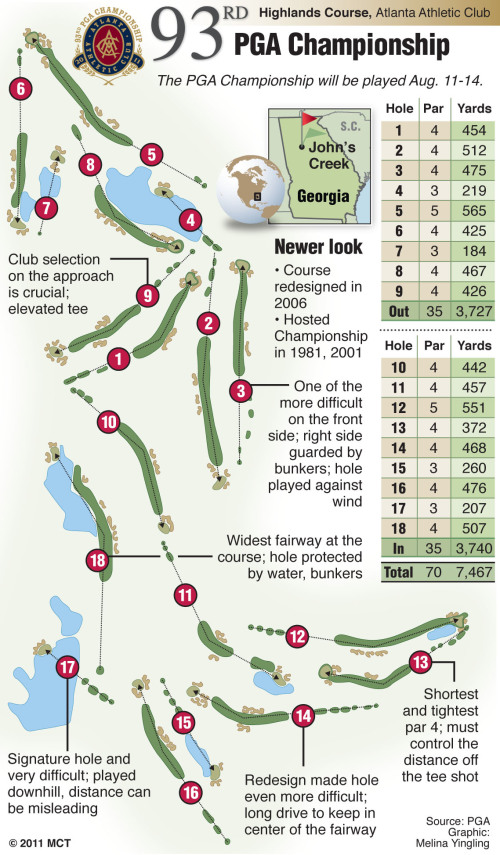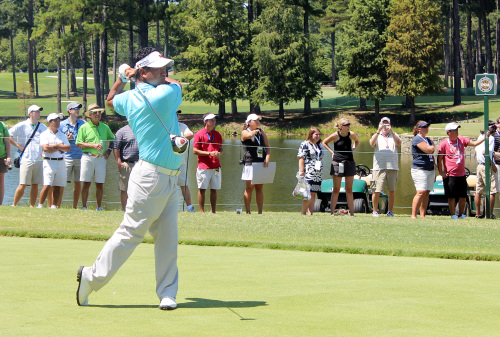JOHNS CREEK, Georgia (AP) ― The question was asked in jest.
For the U.S., this is no laughing matter.
Here we are at another of golf’s major championships, the final one of the year, and the Americans are still mired in their longest drought of the modern era.
No need to push the panic button just yet, but it’s not out of line to wonder just what’s wrong with the red, white and ohhh-sooo-blue.
Or, as a reporter jokingly put it to the most recent non-U.S. winner, British Open champion Darren Clarke, do you think the Americans will win another major in our lifetime?
“I’m sure its cyclical at the moment and the Americans will start winning again very, very soon,” the Ulsterman said. “But at the moment, it’s a wonderful time for the European Tour.”

For the U.S., this is no laughing matter.
Here we are at another of golf’s major championships, the final one of the year, and the Americans are still mired in their longest drought of the modern era.
No need to push the panic button just yet, but it’s not out of line to wonder just what’s wrong with the red, white and ohhh-sooo-blue.
Or, as a reporter jokingly put it to the most recent non-U.S. winner, British Open champion Darren Clarke, do you think the Americans will win another major in our lifetime?
“I’m sure its cyclical at the moment and the Americans will start winning again very, very soon,” the Ulsterman said. “But at the moment, it’s a wonderful time for the European Tour.”


Heading into the PGA Championship, which begins Thursday at Atlanta Athletic Club, the Americans tends to shrug off the lengthy dry spell as largely a media creation, an attempt to divvy up players based on nationality when actually they have much in common.
There are plenty of top international players competing regularly on the PGA Tour and living in this country at least part of the year.
Take Graeme McDowell. The 2010 U.S. Open champion may be from Northern Ireland, but he played college golf in Birmingham, Alabama, and has already competed in a dozen PGA Tour events this year.
Germany’s Martin Kaymer (2010 PGA Championship) has a home in Scottsdale, Arizona. South Africa’s Charl Schwartzel (2011 Masters) joined the PGA Tour this year. Northern Ireland’s Rory McIlroy (2011 U.S. Open) says he might follow Schwartzel to this side of the Atlantic.
“If you look at the last 10 years, we’ve done pretty well,” Dustin Johnson told a group of reporters. “It just gives you guys something to talk about.”
Still, it stings just a bit, especially when everyone keeps bringing it up.
“We don’t sit around and talk about it over lunch or anything,” said Steve Stricker, the highest-ranked U.S. player at No. 5. “I’ve thought about it. I think all the American players have thought about it because it’s in the story, it’s in the media quite a bit.
“What’s happened in the last six majors,” he added, “fuels the fire of the Americans to try to get better and to work at it and try to break that streak, no doubt.”
There’s no disputing the top young international players have performed better in the major championships than their American counterparts.
The U.S. has plenty of talent, players such as Johnson, Rickie Fowler and Anthony Kim, none of them older than 27. But that group has been shut out of the major titles.
By contrast, McIlroy got his at age 22. Kaymer, Schwartzel and Louis Oosthuizen (2010 British Open) were all 27 or younger when they triumphed.
“They are used to winning a lot in other countries and other tours around the world, so they are not scared to win,” David Toms said Wednesday.
International players tend to turn pro at an earlier age, allowing them to compete against older, more-experienced foes. In the U.S., the top young prospects tend to put off their pro career until after college.
Ryo Ishikawa has already won 10 times on Japan’s pro tour ― and he’s still a teenager. At this year’s British Open, 20-year-old Tom Lewis became the first amateur in 35 years to lead at a major but was an amateur in name only, having left school at age 16 to devote himself fully to golf.
Just last week, Toms chatted with Spain’s Miguel Angel Jimenez about the differing career paths.
“He said he turned pro at 18,” Toms marveled. “He was a caddie. He went from being a caddie to being a professional, and that just doesn’t happen over here. We have the college system over here and all these kids want to get their education and have something to fall back on.”
The international players appear to have the edge at the beginning, but it might be worth checking back a few years from now.
“Does it help them? Sure, it helps them early in their career,” Toms said. “But in the long run, when a guy is 35 years old and you look back and see who does it better, I think it all averages out.”
Regardless, there’s no going back to the era when the U.S. dominated the major scene, led by players such as Jack Nicklaus, Arnold Palmer, Lee Trevino and Tom Watson. In the 1960s, the Americans claimed 31 of 40 championships. In the 1970s, their supremacy was even greater: 33 of 40.
Golf has spread far beyond its traditional base in the U.S., Britain, Australia and South Africa, embraced now on the entire European continent and poised for its greatest growth in Asia.
Yang Yong-eun became the first Asian to win a major, rallying to beat Tiger Woods at the 2009 PGA Championship, a symbolic win if there ever was one. No one believes that Yang will be the last golfer from that part of the world to capture one of golf’s biggest titles, especially when the sport is poised for another international boost when it joins the Olympics in 2016.












![[Today’s K-pop] BTS pop-up event to come to Seoul](http://res.heraldm.com/phpwas/restmb_idxmake.php?idx=644&simg=/content/image/2024/04/17/20240417050734_0.jpg&u=)




![[KH Explains] Hyundai's full hybrid edge to pay off amid slow transition to pure EVs](http://res.heraldm.com/phpwas/restmb_idxmake.php?idx=652&simg=/content/image/2024/04/18/20240418050645_0.jpg&u=20240419100350)

